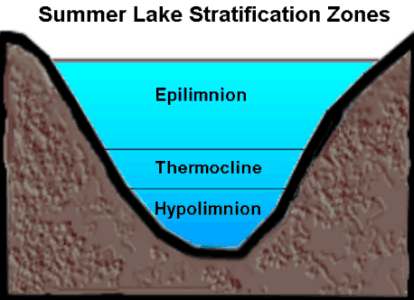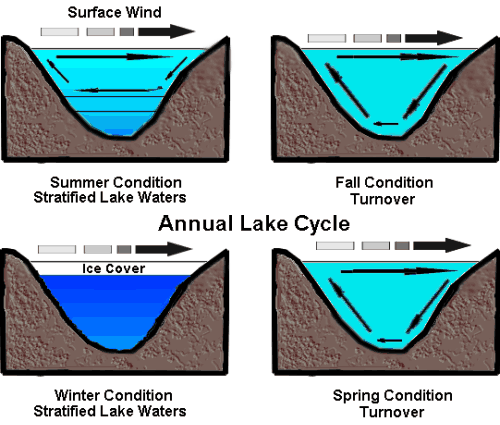 |
 |
| Home | Welcome | What's New | Site Map | Glossary | Weather Doctor Amazon Store | Book Store | Accolades | Email Us |
 | |||||||||
Fall/Spring Lake TurnoverWe generally think of weather processes as occurring from the surface upward into the atmosphere, but weather has its influences downward into the soil and water bodies as well. Many atmosphere-ocean interactions are well known, particularly those siblings El Niņo and La Niņa. Atmosphere-lake interactions produce lake-effect snow squalls. Seasonal weather interactions play major roles in the processes and ecology of even the smallest freshwater lakes. One of the more important is the annual turnover cycle of a fresh-water lake's water mass. This process happens in many lakes, but not all go through the cycle, particularly those in regions where the temperature rarely drops below 4oC (39oF). Whether one does or not can depend on its size, depth and geographical location. Such lakes develop a highly stratified density (temperature) profile as one descends from the surface to depth.I'll begin this look at the turnover cycle in late summer when lake surface waters have reached their annual maximum temperatures. At this time in a sufficiently deep lake, you will find a definite stratification or layering of water temperatures. If a lake is too shallow, wind blowing over the lake surface thoroughly mixes the waters and prevents the development of significant stratification. Warmest, and therefore least dense, waters lie on top, and the water temperature decreases with depth, reaching its minimum temperature at the greatest lake depths. How cold the lake bottom water becomes depends on the lake depth and other characteristics (I assume for this discussion no major rivers or streams enter the lake to affect the stratification), but it will never fall below 4oC (39oF). Three Water LayersWith stratification in place in a "deep" lake, we can define three major layers within the lake.
Winds blowing over the lake generally keep the epilimnion stirred by pushing a quantity of surface water downwind. This draws a flow of deeper water upward (upwelling) along the upwind (windward) shore to replace the pushed waters. As a result, epilimnion waters mix, producing generally warm temperatures and high oxygen content (important to fish and other creatures) throughout the layer. Atmospheric oxygen is added by the air-water interaction to the oxygen produced within the water by aquatic plants.  The thermocline layer has minimal mixing, and what does occur is slow, thus isolating the bottom waters from the surface zone. Because this region lies between the epilimnion and hypolimnion, it is also called the mesolimnion (meso- meaning "middle"). The hypolimnion is a deep-water stagnant layer where plants alone cannot produce enough oxygen for the layer's demands. As a result, the hypolimnion is not only depleted or devoid of oxygen, it often contains high concentrations of dissolved hydrogen sulphide and other sulphurous gases, forcing many creatures to move to shallower waters. Seasonal Stratification CycleWhen the annual seasonal cycle enters late summer and autumn, cold air masses begin dragging polar air southward and the diminishing hours of sunlight allow more radiational heat to escape than is gained from the sun during the day. As a result of both radiational cooling and contact cooling with colder air, lake surface waters start to cool from their summer peaks. Though the epilimnion lake waters cool slowly, their eventual drop in temperature makes them denser than the waters below. When these surface waters reach around 10oC (50oF), they sink through the epilimnion into the thermocline waters below. This begins erasing the temperature stratification that had built during summer. (Note that this is a generalization, and each lake can behave a little different based on a number of other factors including is surface area and depth.)  As the thermocline breaks down and upper water temperatures cool to those of the hypolimnion, the full water mass reaches a uniform temperature, and the surface winds are now able to mix the full water body. When the winds are strong and fairly constant in direction for an extended time, the wind establishes a water circulation within the lake. As surface waters are blown downwind, waters from below must rise along the windward shore to replace those waters pushed across the surface. Bottom waters must then rise to replace the ascending waters; and to complete the circuit, leeward shore surface waters, piled up by the wind, must sink to replace the ascending bottom waters. The resulting circulations will, over time, completely overturn and mix the full lake water mass. This is what is called fall turnover. When the first deep waters rise to the surface, they release their sulphurous gases into the air, often producing a telltale rotten-egg odour. Eventually, the turnover mixes atmospheric oxygen into the full water mass, replenishing the oxygen in deep waters and cleansing the sulphurous gases. This allows fish to return to the depths where many will overwinter. As the winter approaches in areas where subfreezing temperatures are common, the lake surface temperatures approach the freezing mark. Fortunately for aquatic life — and perhaps all life in these regions — water has a most unique and curious property. Unlike most compounds, water reaches its maximum density as a liquid just before becoming a solid. Under normal conditions, freshwater is most dense at 4oC (39oF), and solid water or ice, being less dense than liquid water, floats. Thus, as lake waters move toward freezing, the water sinks when it reaches 4oC to the lake bottom. Colder water remains above, perhaps eventually becoming capped by an ice layer which further prevents the winds from stirring the water mass. Think about the consequences for life and climate if ice were denser than water. Instead of floating at the surface, it would sink to the depths, and lakes would fill with ice each winter from the bottom up, eventually providing no liquid water in which fish and other animals could seek refuge. In deeper lakes, it is logical to assume that ice could remain at depth all year long, perhaps not melting, except for small puddles, even in the shallows. Not only would this lead to very different aquatic species inhabiting higher latitude lakes, but the local climate would be greatly altered wherever very cold water bodies remained through the warmer seasons. Completing the cycle, with spring warming the ice melts and cold surface waters warm until they reach the temperatures of the bottom waters, again producing a fairly uniform temperature distribution throughout the lake. When this occurs, winds blowing over the lake again set up a full circulation system, this mixing known as spring turnover. As the warming continues, the three water layers again become established, and our cycle has been completed. Written by
|
|||||||||
 |
To Purchase Notecard, |
Now Available! Order Today! | |
 |
 |
NEW! Now Available in the US! |
The BC Weather Book: |


